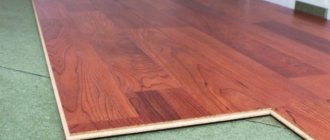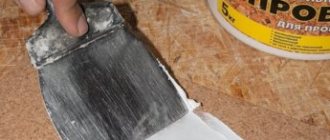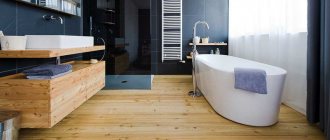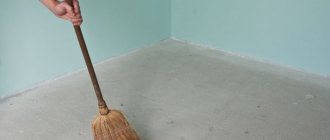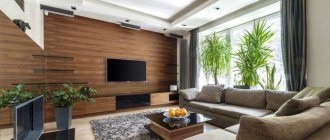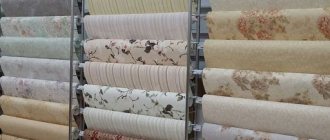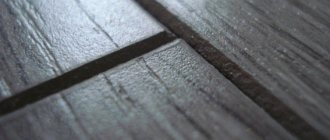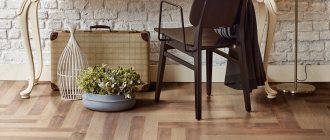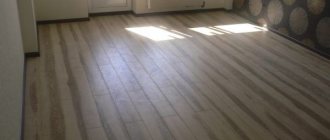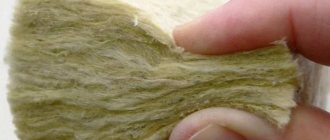Many home craftsmen, at the stage of preparation for renovation, are wondering what to use to attach the cork lining to the floor so that it lasts the entire required period. Reliability of fixation depends not only on the properties of the glue used, but also on compliance with installation rules. The mounting method is chosen taking into account the humidity level in the room.
The reliability of fixation of the cork lining depends on compliance with the installation rules.
Features of cork underlay for laminate
The product consists of sheets with a thickness of 2 to 20 mm, made by pressing crushed cork oak bark.
No synthetic binders are added; suberin, a biopolymer found in plant cells, is used for this. Strong pressure leads to their destruction, as a result of which the “glue” impregnates the material.
Cork backing is available in 2 versions:
- in sheets;
- in rolls.
Purpose
The underlay is laid before laying the following floor coverings:
- laminate;
- linoleum;
- parquet;
- carpet;
- parquet board.
Laminate smoothes out minor unevenness and protects the floor from moisture.
The product performs several functions:
- smoothes out minor unevenness;
- evenly distributes the load on the finished floor;
- provides heat and sound insulation;
- protects the topcoat from moisture;
- fixes the dies so that they do not move or wobble when walking;
- eliminates squeaks;
- prevents dust from entering the joints between the lamellas from the concrete base;
- compensates for the rigidity of the base material, making movement on the floor more comfortable.
Without a lining, the finish coat becomes less durable and may even be unusable.
Advantages
There are also synthetic substrates.
The substrate has strength and the ability to restore shape after deformation.
But cork, despite its relatively high cost, remains the most popular, which is explained by the following advantages:
- strength;
- durability;
- the ability to restore shape after deformation;
- absence of substances harmful to human health;
- good elasticity;
- resistance to rot and mold;
- high noise and heat insulation properties (the material contains microscopic pores);
- antistatic effect;
- hypoallergenic;
- light weight;
- ease of installation.
The material does not support combustion and does not release toxins in the event of a fire.
Advantages
The golden rule for the functioning of any economy is: “the high price of a product must be confirmed by corresponding quality characteristics.” The cork backing for laminate flooring fully complies with this rule. It has many advantages over other types of laminate flooring.
Cork underlay for laminate flooring - pros and cons. The advantages include:
- Durability. The natural material from which this substrate is made retains elasticity, strength and resistance to deformation for up to 30 years. Neither dynamic loads (impacts) nor static loads (constant pressure of furniture) leave dents on it;
- Excellent protection against penetrating noise, especially high tones. A technical plug cannot protect a room from structural noise;
- High thermal insulation properties. Low specific gravity at high density turns cork into an excellent insulation material;
- Ecological cleanliness. The substrate, made artificially from natural raw materials (oak), does not emit any fumes into the air, which turns it into a hypoallergenic material that is completely safe for humans;
- High level of fire safety. Made from wood, such a substrate, however, does not burn well, which provides the room where it is laid with increased fire resistance;
- Light weight, which allows you to reduce the load on the floors and easily transport and lift the material into the apartment (house);
- Does not accumulate static electricity;
- Not subject to rotting, well resistant to fungi, microorganisms and insects, does not serve as a basis for the formation of mold;
- Retains its properties at sub-zero temperatures;
- High level of elasticity over a long period. This ensures dampening of vibrations that occur when walking, good sound insulation of steps and protection of laminate locks when heavy objects fall onto the floor;
- Easy to install. Even a beginner in construction can do the work with his own hands.
Main types
Cork is used not only in its pure form, but also with additives. They are designed to improve its characteristics.
Cork rubber
Option with added rubber. It gives the material the following qualities:
- high moisture resistance;
- elasticity.
The cork rubber lining has high moisture resistance.
The main purpose is use in conditions of high humidity.
Rubber is harmless, therefore this type of substrate is allowed to be used in residential premises, incl. in the design of a “warm floor”.
Due to its elasticity, it is also suitable for laying on wooden bases (they are characterized by great mobility).
Bitumen-cork
A cheaper option for a moisture-resistant lining. It is made using bitumen, which is a toxic substance. The mixture is applied to craft paper.
This plug is allowed to be used only in non-residential premises on unheated floors.
Technical
This is the name given to pure cork intended for installation under other materials. Unlike its decorative counterpart, it is made from low-quality raw materials and does not have an attractive appearance.
The technical lining is made from low-quality raw materials.
Technical cork can be laid in residential premises, but only in dry ones.
Laying features
The cork underlay is laid on a prepared base - a floor screed.
Attention: detailed instructions on how to prepare a wooden floor and concrete floor for installing a laminate (and therefore for laying a cork underlay as well) are given in the works: “Preparing the base for a floor screed”, “Beacons for floor screed”, “Do-it-yourself expanded clay concrete screed” ", "Technology of wet floor screed with expanded clay" and others.
Even a novice builder knows how to lay a cork backing. However, there are several important nuances that need to be taken into account:
- Before starting work, the rolls must be rolled out and cut to the size of the room. The finished sheets should be left for a day in an unfolded position so that they are leveled and do not create waves and swelling when laying the laminate.
- Along the entire perimeter of the room, the distance between the substrate and the wall should be 1 cm. When cutting the last sheet, this requirement should also be observed. To prevent displacement of the sheets, it is necessary to place a lath 8-10 mm thick between the wall and the substrate.
Attention: some craftsmen recommend fixing the substrate near the wall with tape. Practice shows that this method does not always allow maintaining the original position of the plug.
- The sheets of backing are laid tightly together, and the joints are glued together with construction tape 5 cm wide.
- When laying sheet material, the second row should begin with a sheet cut in half to offset the transverse connecting seams. The third row should be started again from a whole sheet.
- According to the technology, the bitumen-cork substrate under the laminate is always laid with the cork layer down.
- In rooms with high humidity, special rubber and bitumen-cork substrates are laid.
- You cannot walk on such a substrate, as it is easily damaged. Therefore, it should be laid correctly according to the scheme: a sheet of cork lining, several rows of laminate on it. After this, the next sheet is laid, the seam is sealed with tape, and work on installing the laminate continues.
- After laying the second sheet of the damper layer, it is easier to work not from the screed, but from the already laid laminate.
What thickness is best to use
Cork underlay for laminate - what thickness to choose? Seemingly simple at first glance, this question determines the durability of the flooring. An error in choosing the thickness of the damper layer will inevitably lead to the destruction of the locking connections of the lamellas. The substrate must be selected according to the following criteria:
- Lining under the lamellas with a thickness of 2 mm is used in rooms with a perfectly flat surface, where there are no differences in height. This material is not suitable for leveling even minimal curvature of 1 mm;
- A damper layer of 3 mm is used for lamellas of medium thickness, leveling differences in screed height of 2 mm, heat and sound insulation;
- A 4 mm thick underlay is laid under thicker and more expensive laminate panels. It also allows you to eliminate the impact of height differences of 3 mm on the floor;
- Substrate with a thickness of more than 4 mm is practically not used either in apartment buildings or in individual construction.
Attention: the point of view that a thicker substrate is better is fundamentally wrong. Technical cork of 5 mm or more quickly deforms and collapses under static loads from heavy furniture (the compression of the lining occurs by 1.5-2.0 mm, in contrast to thinner material, where this figure does not exceed 1.0 mm). Such a deflection quickly breaks the locks of the lamellas. In addition, a thick substrate does not dampen vibration well. When walking, the floor resonates, its vibrations reach 2 mm, which has an extremely negative effect on its durability.
Installation nuances: what to consider
Cork lining is selected taking into account 2 factors:
- laminate thickness;
- heights of irregularities on the base.
Under planks thinner than 8 mm, 2 mm material is laid. For larger ones – thickness 3 (mm).
If there are significant unevenness on the base, regardless of the parameters of the finishing coating, a 3-4 mm substrate is used. The maximum permissible height difference is 2 mm. If the irregularities are larger, they resort to leveling.
Specifications
When installing a laminate floor covering for a concrete floor, it is recommended to take into account the following characteristics of the cork underlay:
- material density – from 180 to 260 kg/m3;
- material resistance – over 2 kg/2;
- change in the initial state (deformation) – at a pressure of 7 kg/2 within 10%;
- residual deformation – after 120 minutes within 0.2%;
- fire resistance class of the material – B2;
- sound absorption ability - from 12 to 17 dB;
- thermal conductivity of the material – from 0.037 to 0.043 W/(m*K);
- the material is a natural antiseptic, does not rot, and is not eaten by rodents.
Working conditions
Installation of technical cork without the addition of rubber and bitumen is carried out on a flat floor with a humidity of no more than 5%. It is not recommended to lay the underlay on the following substrates:
- freshly laid screed;
- ceiling over the bathroom;
- floor above an unheated basement.
The underlay is not laid on a freshly laid screed.
Microclimate parameters in the room where the cork lining is planned to be installed:
- air temperature – not lower than +18°С;
- relative humidity – no more than 60%.
How to lay a cork lining
Any home craftsman can lay the substrate on his own, but in order to avoid common mistakes, it is recommended to adhere to the following instructions:
- before starting work, it is necessary to allow the material to acclimatize at room temperature for about a day;
- if roll material is used, the backing is marked and cut, after which it is left for a day so that the sheets straighten out and take the correct shape;
- cutting is carried out with an indentation of 8-10 mm from the wall; for convenience, you can use an indentation rail around the perimeter of the room;
- in some cases it is recommended to lay sheets on double-sided tape &mdsah; This ensures reliable fixation of the material;
- laying of the backing sheets is done end-to-end, it is recommended to glue the joints with tape;
- if a lining is used in the form of separate sheets, it is necessary to provide a staggered joining order &mdsah; to do this, a new row begins with laying half a sheet, the next one again with a full one, and then in the same sequence;
- when installing floors in facilities with high humidity, rubber-cork and bitumen-cork pads are used &mdsah; when laying them, it is necessary to turn the natural layer towards the concrete surface;
- It is not recommended to walk on the lining, so laying the underlay is combined with the installation of the laminate &mdsah; Having finished installing several rows of boards, they continue to lay the substrate, then install the laminate again, and so on until the work is completely completed.
Preparatory activities
Before installation, the base is leveled. If it is a concrete slab, do the following:
- Remove garbage.
- The loose edges of cracks and other defects are beaten and filled with mortar.
- Place a screed or pour in a self-leveling solution.
- Prime the base.
With a wooden base proceed as follows:
- Inspect for rotten areas, cracks and other damage.
- Boards with defects are replaced.
- Tighten the fastenings of loose elements.
- If there are large irregularities, the surface is scraped and ground.
Before installation, the base is primed and leveled.
If the wooden base cannot be leveled to an acceptable level, a “dry screed” sheet material is placed on top of it:
- plywood;
- gypsum fiber;
- Chipboard.
It is recommended to lay it in 2 layers with overlapping seams.
“Dry screed” is also laid on top of concrete - this floor becomes warmer.
Plywood is pre-treated with fire protection, antiseptic and impregnation, which imparts moisture resistance.
Before installing the substrate on the floor of the first floor or located above a damp room, the base is covered with polyethylene film with a thickness of at least 150 microns. The overlap is 10 cm, the joints are taped. The approach to the walls is at least 50 mm.
The preparatory stage is completed by delivering the cork to the premises. Here it is unrolled and laid out on the floor, giving the opportunity to lie down and acclimatize. Installation begins a day later.
Correct selection
So, you already know everything about cork and its types. Now let's decide what exactly you should buy in stores. For laminates up to 8 mm thick, a 2 mm thick underlay is usually used. For laminates with a thickness of 8 to 12mm (or more), a 3mm backing is used.
A thicker backing is also available, but we do not recommend you use it - the laminate will sag greatly when walking and under load, which will negatively affect the locks (they become loose and burst). In living rooms, use a regular technical layer. In the baths there is bitumen.
Mounting methods
There are 2 methods of fixing the lining. Each of them has its own advantages and disadvantages.
The underlay is spread on the floor and glued to the concrete slab.
"Dry" method
The first method involves the following procedure:
- The substrate is spread on the floor.
- They are cut at the walls so that there is a gap of 1 cm wide between them and the material (temperature joint).
- Wrap the edge of the first roll and mark the joint line on the base with a few strokes.
- Bend over the adjacent panel and glue a strip of 2-sided tape at least 5 cm wide to the concrete slab along the markings.
- Return the edges of the rolls to their place, as a result of which they will stick to the base in the joint area.
- The remaining seams are fixed in the same way.
- They are glued on top with single-sided tape.
If cork is used in sheets, they are placed with seams spaced apart.
The advantage of the “dry” method is minimal labor costs.
Disadvantage: low reliability. If the cork moves, due to its fragility it will quickly collapse.
Adhesive
This method provides a stronger fixation, which is why the method has become the most popular. Use 2 types of glue:
- acrylic - applied only to the base;
- contact (a group of substances based on synthetic resins and rubbers) - spread on both surfaces.
Contact adhesive has good moisture resistance and stability.
You cannot use PVA - it will cause the material to swell.
Contact adhesive is preferred. It has the following advantages:
- good moisture resistance;
- high adhesion;
- resistance to acids and alkalis;
- wide range of operating temperatures.
There are adhesives:
- water based;
- with solvent.
The second ones are more reliable, because retain their performance when in contact with water, for example as a result of flooding. But they require compliance with safety regulations:
- installation is carried out in a well-ventilated area;
- The operator’s hands and eyes are protected with gloves and goggles, and the respiratory tract is protected with a respirator.
There are mixtures based on organic solvents, for example, Bunitex or Cork House. They are more environmentally friendly.
The most popular brands of glue are:
- Wakol – latex-acrylic.
- Ibola D7 Contact – contact, solvent-free.
- Stauf Multicontact - universal contact, does not contain solvent, suitable for underfloor heating.
- Uzin KE 2000 S is a dispersion-based composition for elastic materials, used for gluing rubber-cork backing.
- Decol Vern - polychloroprene based with synthetic resins (respiratory and skin protection required).
Wakol is the most popular acrylic adhesive.
Installation of the lining using the adhesive method is carried out in the following order:
- The material is laid out dry and trimmed against the walls so as to form an expansion joint around the perimeter.
- Turn over the outer panel or sheet, apply glue to its underside with a roller, and apply glue to the free base with a notched trowel.
- Wait about 15 minutes (the exact time is indicated in the instructions for the adhesive composition).
- Turn the backing over and glue it to the base.
- Roll it with a clean, dry roller or tap it with a rubber hammer to achieve a tight fit.
- The remaining fragments of the lining are mounted in the same way.
You can walk on the newly glued cork. But furniture is allowed to be installed no earlier than one day later.
Popular manufacturers
The most popular substrates from Portugal include the following brands:
- Wicanders;
- Sedacor;
- Vintage;
- Egen.
In addition to Portuguese companies, in domestic retail you can find products made in Germany (Tarkett), Poland (Decora) and Spain (Ibercork).
Cost of popular substrates.
Approximate cost of material
The price of cork backing depends on its thickness. Thin material is cheaper. Average cost of 1 sq. m in rub. is:
- in sheets – 400-1000;
- in rolls – 70-750.
Examples:
| Brand | Thickness | Cost, rub. |
| MGO | 2 | 148 |
| Cork4u | 2 | 1300 |
| Cork4U | 3 | 2100 |
| Amorim | 2 | 1570 |
| Amorim | 3 | 2190 |
| Amorim | 4 | 2950 |
| Corksribas (in sheets) | 4 | 205 |
| Decortica | 5 | 3800 |
"Golden mean" between thin and thick substrate
Laying options for laminate panels.
If you lay the laminate on a thicker cork base, you can get a “floating” type floor that will not be able to withstand heavy loads. 4 millimeters is a critical value for the thickness of the substrate. However, 2 millimeters will be enough to protect the laminate.
In what form is cork backing available?
- Roll materials.
- Plates or sheets 915x610 millimeters.
Negative sides of cork backing
The material has the following disadvantages:
- High cost.
- The presence of dents due to prolonged exposure to a point load (legs of a heavy piece of furniture, etc.).
- Lack of moisture resistance: with prolonged contact with water, the material swells.
- Fragility (except for cork with added rubber).
Cork backing is expensive.
Thermal insulating properties make cork an unsuccessful solution for use in heated floor construction.
Flaws
In addition to the high price, cork substrates have other disadvantages:
- Cannot be used in wet areas (bathroom, kitchen);
- Requires mandatory waterproofing (does not apply to the rubber-cork type). This disadvantage is relative, since laminate manufacturers require waterproofing work before laying the lamellas;
- It often deforms and crumbles under the heavy weight of furniture, with, attention, a very small point of support, which leads to the destruction of the locking joints of the laminate;
- Does not protect against structural noise (operation of a drill, elevator, etc.);
- Due to low thermal conductivity, it cannot be used in underfloor heating systems.
Useful tips and general recommendations from experts
You can’t save on traffic jams, because... poor quality of the substrate greatly affects the service life of the laminate. At the same time, it is not always worth buying the most expensive option: the products of many companies in the middle price segment are of acceptable quality. It is also inadvisable to purchase an elite class cork if you intend to install a cheap laminate.
Other recommendations:
- Use thick cork only if absolutely necessary - it sags greatly under load.
- Do not use water-based glue in damp areas.
- If you are short on time, choose a composition with a solvent - it sets faster and gains strength.
After applying the glue, you need to wait a few minutes for it to dry. If you hurry, the composition will take a long time to set, but overexposure is undesirable. It is convenient to use glue, which visually notifies you of its readiness. For example, the composition of the Wakol brand turns from white to transparent.
What properties should a warm substrate have?
The lining under the laminate must have the following properties:
- Sound absorption. Without a pad, every step will be accompanied by creaking and tapping, which reinforces the wood or concrete surface. Soft material ensures the absence of squeaks, knocks and other noises.
- Settlement. If you lay laminate directly on the base of the floor, the sheets will sag and move under the weight of steps, causing the seams to begin to separate, which will lead to a reduction in service life. The installation technology provides for a height difference of 1-2 mm, no more. Therefore, the substrate should not be too thick, so as not to sag under the weight of the person walking.
- Waterproof and steamproof. If the laminate is constantly exposed to dampness, it will swell over time and can simply be thrown away. The underlay protects the panels from moisture that comes from the cement floor.
- Thermal conductivity. This property is especially important if heated floors are installed under the laminate or the room is located above the basement. The thickness of the material should not exceed 3 mm.
Reviews about the material
Semyon, 34 years old, Novocherkassk:
“Cork is an expensive, but good, durable material. There is no point in putting it under a cheap laminate, but under an elite or average quality one - that’s it. I recommend that you carefully choose the seller and brand. I heard from friends that there are cheap brands and fakes on sale, which soon crumble into dust.”
Maxim, 42 years old, Novokuznetsk:
“I approve of cork substrates based on their characteristics, but I think their use is unjustified due to the high price. It is better to lay pine plywood: the costs are comparable, and the material does not wrinkle or crumble. Resinous wood, like cork, does not rot or mold. I did this myself many years ago and I don’t regret my choice.”
Valentina, 36 years old, Rostov-on-Don:
“I’ve been doing renovations for several years now.
I always recommend to my clients to use cork backing – it has never failed me. The price may seem high, but you need to take into account that it lasts a long time.”
The meaning of the substrate: composition, types, functions, pros and cons
On the building materials market, among related products, there is a huge selection of all kinds of substrates, differing in composition, performance characteristics and price. Depending on the material, laminate linings can be divided into three groups:
- Natural products, including cork backing.
- Synthetic, which in turn are grouped into:
- expanded polystyrene;
- polyethylene foam;
- combining both materials.
- Combined substrates made from natural cork mixed with natural or synthetic rubber or bitumen.
Naturally, cork substrate is considered elite, but its purchase is not always justified, since the price of such a product reaches 20% of the cost of laminated panels in the middle price range. Main functions of substrates:
- shock-absorbing;
- sound and heat insulating;
- leveling;
- and for some types also vapor and waterproofing.
Unfortunately, the natural substrate does not have all these qualities; in particular, it does not have a sufficiently high level of water resistance.
Therefore, you need to choose a substrate based on expediency and following the truism - you should not lay an expensive natural substrate under a cheap laminate and, conversely, when purchasing expensive laminated panels, you should not purchase a synthetic substrate.
Is it possible to do without a lining at all when installing a laminate floor? In principle, it is possible provided that the working surface is perfectly leveled or if the substrate is included in the laminate as an additional layer. But such brands of flooring are extremely rare on sale, and they are much more expensive.
